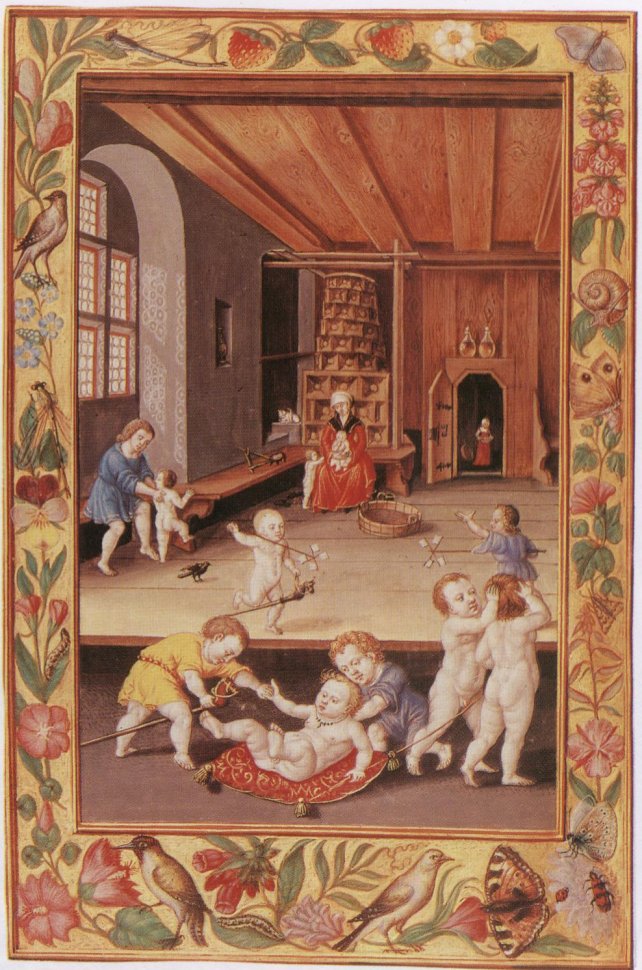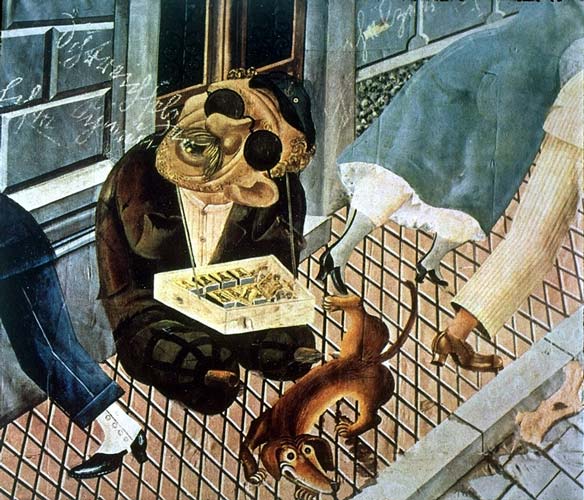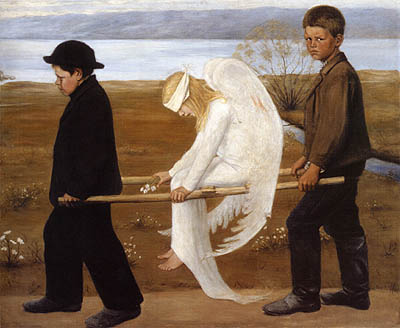The Belgian film Hasta La Vista, about three disabled young men on a road trip in Spain’s wine country to lose their virginity in a specialty bordello, has been getting some critical acclaim, most notably, the grand prize at the Montreal World Film Festival. Not surprising, given the film’s firm European bent; this one on the subject of cripples, the disabled, which has a long tradition in northern Renaissance painting that include Durer, Cranach, Bruegel, Bosch, Grunewald and others which linked suffering to Chrsitianity and the symbolism of ugliness and shame to an aesthetic of poverty contrasted with an upper class appropriation of Jesus.

---Nothing will stop them despite the fact that one is blind, another is confined to a wheelchair and the third is completely paralyzed. "For me this is a very human story. What I wanted to achieve is that after a few minutes people actually forget that these main characters are physically challenged. They are just human beings, like you and I, looking for some warmth, some tenderness,” Enthoven said.--- Read More:http://www.cbc.ca/news/arts/story/2011/08/29/montreal-film-festival.html
Come As You Are ( Hasta La Vista ) is a reflection of this tradition; mankind being depicted as a collection of the disabled and crippled struggling towards an intense and rich interior existence where a righteous, traditional sense of morals translates into a new formulation. The negative hero where isolation and silence are appropriate responses which reveal a hidden divinity. Again, its a protestant language of visual art, a representation loaded with paradox that ends up revealing only through the art of concealing.

Read More:http://www.montrealgazette.com/entertainment/Definitely+your+average+comedy/5280884/story.html
Its an artistic vision spun from the Protestant Reformation of Luther and which was subsumed by more materialistic themes by the middle of the seventeenth-century as Lutherism resembled the opulent Christianity it had fought against. Its apotheosis was with Rembrandt, most noticeably, where the imagery of the fallen and ugly would transfigure humanity through divine love in opposition to the bourgeois materialist values. It was the paradox of a soul hidden, yet radiating a message that the ugly and fallen were objects of special divine love and acted as messengers to those, ironically too blind and emotionally crippled to understand…
From Variety Magazine: Three young special-needs men go on a road trip to lose their virginity in Belgian helmer Geoffrey Enthoven’s “Come as You Are,” a likable if somewhat formulaic-feeling seriocomedy loosely inspired by Asta Philpot, the U.S.-born Brit advocate for handicapped persons’ sexuality. …

Bruegel. The Cripples.---It is because of Bruegel's vision that the present-day observer finds it interesting. The artist sees the people not in God's image but as imperfect beings, the dust of the ground from which they were created characterizing them more than the divine breath which was breathed into it. Bruegel is demonstrating even more clearly than usual that the difference between man and animal is by no means as great as one might think. In taking the cripples' legs, he has stripped them of their means of walking upright. This has nothing to do with resignation; indeed, it seems more of a matter-of-fact observation. Nor is there any sense of sympathy; evidently this was relatively uncommon in the 16th century, there being simply too many beggars in the streets and in front of the churches. And anyway, Bruegel's concern was not so much with the beggars as such, of course, as with beggars as representatives, whether of social groups or of a specific conception of man.--- Read More:http://www.all-art.org/early_renaissance/bruegel09-1.html
…The protags are friends in a well-heeled suburb, brought together (and isolated from other peers) by their different disabilities. Genial Jozef (Tom Audenaert) is almost completely blind. Often childishly petulant prankster Philip (Robrecht Vanden Thoren) is a paraplegic. Likewise wheelchair-bound, Lars (Gilles De Schryver) has a degenerative terminal illness that is causing paralysis and occasional fits. All still live with their parents, from whom they require considerable assistance. But dreams of independence take flight when Philip hears about a Spanish brothel catering to people “like us.” He announces they must go there on vacation, alone — well, aside from a hired caretaker.
Their families are not at all excited about this idea, though they reluctantly agree once a reassuringly experienced van driver/nurse is recruited. All plans are scotched, however, when Lars’ prognosis takes a turn for the worse. Without much time left, he determines he’ll live it to the hilt — so the threesome sneak away on their trip after all, parental concern be damned.
With the first nurse/driver having declined the job, the three are stuck with a seemingly far less desirable chaperone: Claude (Isabelle de Hertogh), a gruff, heavyset woman who speaks only French. They resent her presence at first; Philip is particularly rude, as is his wont. But after she saves the day in an emergency or two, the collective mood lightens. Slapstick mishaps happen, life lessons are duly learned, tragedy is confronted and so forth.

Bruegel. Parable of the Blind. ---The title of Bruegel’s painting derives from a passage in the New Testament (Matthew 15:14) in which Christ is comparing spiritual blindness to physical blindness and talking about inner blindness to religion of some people. It all came about as Jesus had told his disciples that it was not necessary to wash hands before eating. This remark was overheard by the Scribes and Pharisees and they were infuriated, as it was a patent infringement of Jewish law. When the disciples reported this to Jesus, he replied: “…They are blind guides leading the blind, and if one blind person guides another, they will both fall into a ditch….” Before us we see a line of six men walking along a dirt track. They are a bunch of unkempt, unshaven peasants. They are painted in a frieze-like procession and the line of men surges diagonally, top left to bottom right of the painting which otherwise had been beautifully balanced both horizontally and vertically. They move together in a group ensuring they do not lose contact with each other as they can be seen holding the same stick in pairs or in some cases each has a hand on the shoulder of the man in front. However their strategy did not work and we see that the leading blind man has fallen into a ditch and the second man in the line is now tripping over his fallen leader.--- Read More:http://myda
rtdisplay.wordpress.com/2011/07/11/the-parable-of-the-blind-by-pieter-bruegel-the-elder/Fictitiously elaborating on Philpot’s real-life trips to a wheelchair-accessible Spanish brothel and his advocacy of prostitution as one sexual-expression option for the disabled, Pierre De Clercq’s episodic script runs a familiar gamut from laughter to tears. But it’s never condescending.

----Furthermore, one of the paintings of Splendor Solis (1582) shows ten infant boys at play, and the accompanying bath provides still another link with the Saturnine mysticism, which was often associated with moisture or wetness. Thus Saturn, in the guise of a crippled or wooden-legged man with a watering-pot, is sometimes shown watering the Sun Tree and Moon Tree of the alchemists. The crippled Saturn symbolizes the slow and melancholy planet, Saturn, and the dull and heavy metal, lead, with which the planet was associated in alchemy. Again, the "labor fit for women" is frequently brought out in alchemical pictures of washerwomen engaged in their humid operations. From this point of view it is interesting that Durer's design has a watery background.--- Read More:http://www.alchemylab.com/melancholia.htm
—————————————————

---After the war Dix developed left-wing views and his paintings and drawings became increasingly political. Like other German artists such as John Heartfield and George Grosz, Dix was angry about the way that the wounded and crippled ex-soldiers were treated in Germany. This was reflected in paintings such as "War Cripples", "Butchers Shop", and "War wounded". Dix joined with other artists who had fought in the first WW to put on a traveling exhibition of paintings called No More War. During this period he had also made use of photographs that had been taken of German soldiers who had been badly disfigured by the war. In 1933 when Hitler came into power, the Nazi government disliked his anti-military paintings and had arranged for him to be sacked, and in the process managed to destroy all of his anti-war paintings.--- Read More:http://ww2artists.blogspot.com/2007/12/otto-dix.html
————————————-

Dix. The Matchseller 1920. Read More:http://naturesnotaskindasbooks.blogspot.com/2011/02/otto-dix-and-matthias-grunewald.html
————————————–
Though a few of Rembrandt’s beggar prints depicted crafty, humorous figures in keeping withtraditional moralizing and satirical images of the poor, most used shabbiness and filth as a paradoxical veil, simultaneously hiding and revealing human beings crushed by larger socialforces. While this unprecedented combination of repugnant ugliness and inner humanity may haveoffended bourgeois Dutch eyes, it yet reflected contemporary modes of charity. If Protestant Holland rejected Catholic alms giving which functioned as a “good work” leading the wealthybenefactor to heaven, poor relief remained nonetheless an individual spiritual and moralobligation. Read More:http://www.scribd.com/doc/57145923/Baldwin-Rembrandts-Art-of-Paradox

---The Isenheim Altarpiece embodies the human condition laid bare—from the extremes of catastrophic darkness to the rapture of resurrection and eternal life. The graceful, linear quality of the drawing and the vibrant, expressionist use of color would be enough to set this work apart—but Grünewald’s individualistic iconography and the intense emotional impact of the Isenheim Altarpiece make it completely unique. There is also another aspect of the Isenheim Altarpiece which intensifies its powerful spiritual presence—it was commissioned by the monks of a medieval hospital in the tiny hamlet of Isenheim to help lessen the suffering of their patients afflicted with a terrible skin disease called St. Anthony’s fire, or ergotism, which was caused by rye fungus. In a time before painkillers, the patients meditated on Christ’s intense suffering and resurrection to help them cope with their own agonies.--- Read More:http://venetianred.net/2010/01/19/mathias-grunewalds-isenheim-altarpiece/
Read More:http://www.variety.com/review/VE1117945899/
Read More:http://deficienciavisual9.com.sapo.pt/r-Portrayals_of_blind_in_art_history-Lucia_Reily.htma

---Amaranth, The Wounded Angel (1903) is a painting by symbolist painter Hugo Simberg. In The Wounded Angel the healthy boys are carrying the injured girl towards the Blind Girls’ school and the Home for Cripples. She clutches a bunch of snowdrops, symbolic of healing and rebirth. --- Read More:http://witchmountain.tumblr.com/post/3366192140/amaranth-the-wounded-angel-1903-is-a-painting
ADDENDUM:
So too, Rembrandt’s vagabond etchings and drawings sought out Christ among the rags and poor people of Amsterdam. Transfigured into a spiritual quality by his mood-setting chiaroscuro, the poverty of Christ evoked the Protestant mystery of the hiddden God stressed repeatedly by Luther, and here, Calvin.He came into the world so as to be everywhere despised; his glory lay hid under the humble form of the flesh; for though a majesty worthy of “the only-begotten Son of God” shone forth in him, yet the greater part of men did not see it, but, on the contrary, they despised that deep abasement which was the veil or covering of his glory…the shame of the cross…Such imagery lay at the heart of two of Rembrandt’s greatest etchings, the Hundred Guilder Print and the Three Crosses. In the former, blind beggars and cripples moved toward Christ, much as they did in an earlier Protestant emblem representing the human condition. By integrating a variety of narrative incidents from Matthew, Rembrandt revealed a divine love encompassing all of society, even the outcast, the sick, the elderly, and the infantile. “Poor”, “sick”, “blind”, and “childlike”, the Protestant human being can only”beg” for grace. In turn, the mystery of God’s love for fallen mankind was powerfullyexpressed, a theme brought out in a passion oration by Rembrandt’s contemporary, Daniel Heinsius. Read More:http://www.scribd.com/doc/57145923/Baldwin-Rembrandts-Art-of-Paradox





 COMMENTS
COMMENTS